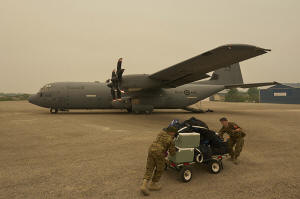Canadian wildfire smoke causes 'very unhealthy' conditions in American
Midwest and reaches Europe
[June 04, 2025]
By STEVE KARNOWSKI
MINNEAPOLIS (AP) — Smoke from Canadian wildfires carried another day of
poor air quality south of the border to the Midwest, where conditions in
parts of Minnesota, Wisconsin and Michigan were rated “very unhealthy”
Tuesday.
The fires have forced more than 27,000 Canadians in three provinces to
flee their homes, and the smoke has even reached Europe.
The smell of smoke hung over the Minneapolis-St. Paul area on Tuesday
morning despite rain that obscured the full measure of the dirty air.
The Minnesota Pollution Control Agency issued an alert for almost the
entire state into Wednesday, but the Twin Cities area got the worst of
it in the Midwest on Tuesday.
“As the smoke continues to move across the state Tuesday, air quality
will slowly improve from northwest to southeast for the remainder of the
alert area,” the agency said. “The smoke is expected to leave the state
by Wednesday at noon.”
The Iowa Department of Natural Resources warned that air quality in a
band from the state’s southwest corner to the northeast could fall into
the unhealthy category through Thursday morning. The agency recommended
that people, especially those with heart and lung disease, avoid long or
intense activities and to take extra breaks while doing strenuous
actions outdoors.
Smoky conditions that have reached the U.S. periodically in recent weeks
extended as far east Tuesday as Michigan, west into the Dakotas and
Nebraska, and as far to the southeast as Georgia.

Conditions at ground level are unhealthy
The U.S. Environmental Protection Agency's AirNow map showed a swath of
red for “unhealthy” conditions across the eastern half Minnesota into
western Wisconsin and northern Iowa. The map also showed purple for
“very unhealthy" across much of the Minneapolis-St. Paul metropolitan
area, where the Air Quality Index numbers of 250 and were common, though
conditions started to improve slightly by late morning.
The Air Quality Index — AQI — measures how clean or polluted the air is,
focusing on health effects that might be experienced within a few hours
or days after breathing polluted air. It is based on ground-level ozone,
particle pollution, carbon monoxide, sulfur dioxide, and nitrogen
dioxide. Particulates are the main issue from the fires
The index ranges from green, where the air quality is satisfactory and
air pollution poses little or no risk, to maroon, which is considered
hazardous. That level comes with health warnings of emergency conditions
where everyone is more likely to be affected, according to AirNow.
While Minnesota officials warned on Monday that conditions in the
northwest part of the state could reach the maroon category on Tuesday,
conditions there were generally yellow, or moderate. There were a few
scattered locations in the Twin Cities area that temporarily hit maroon
on Tuesday morning. But by midday Tuesday, most of the remaining maroon
spots in the region were on the Upper Peninsula of Michigan.
Hospitals are seeing more patients with respiratory symptoms
Hennepin Healthcare, the main emergency hospital in Minneapolis, has
seen a slight increase in visits by patients with respiratory symptoms
aggravated by the dirty air.
Dr. Rachel Strykowski, a pulmonologist, said there is usually a bit of a
delay before patients come in, which is unfortunate because the sooner
those patients contact their doctors, the better the outcome. Typical
symptoms, she said, include “increase in shortness of breath, wheezing,
maybe coughing a bit more, and flares of their underlying disease, and
that's usually COPD and asthma.”

[to top of second column]
|

Royal Canadian Air Force Pte. Carter Brinn (left) and Cpl. Ethan Cai
helps load cargo as evacuees from Pinaow Wachi Care Home board a
C-130 Hercules aircraft in Norway House, Man., Tuesday, June 3,
2025, at the Norway House Airport as crews continue to fight
wildfires in northern Manitoba. (David Lipnowski/The Canadian Press
via AP)

What happens, Strykowski said, is that the fine particulate matter
from the wildfire smoke triggers more inflammation in patients'
airways, aggravating their underlying medical conditions.
Strykowski noted that this is usually a time those patients can go
outside and enjoy the summer weather because there are fewer
triggers, so the current ones forcing them to stay inside can feel
“quite isolating."
People can protect themselves by staying indoors or by wearing N95
masks, she said. Strykowski added that they must be N95s because the
cloth masks many people used during the COVID-19 pandemic don't
provide enough filtration.
The Canadian fire situation
Canada is having another bad wildfire season, and more than 27,000
people in three provinces have been forced to evacuate. Most of the
smoke reaching the American Midwest has been coming from fires
northwest of the provincial capital of Winnipeg in Manitoba.
Winnipeg hotels opened Monday to evacuees. More than 17,000 Manitoba
residents have been displaced since last week, including 5,000
residents of the community of Flin Flon, nearly 400 miles (645
kilometers) northwest of Winnipeg. In neighboring Saskatchewan,
2,500 residents of the town of La Ronge were ordered to flee Monday,
on top of more than 8,000 in the province who had been evacuated
earlier.
In Saskatoon, where the premiers of Canada’s provinces and the
country’s prime minister met Monday, Saskatchewan Premier Scott Moe
said all of Canada has come together to help the Prairie provinces.
Two people were killed by a wildfire in mid-May in Lac du Bonnet,
northeast of Winnipeg.
Canada’s worst-ever wildfire season was in 2023. It choked much of
North America with dangerous smoke for months.

The smoke reaches Europe
Canada’s wildfires are so large and intense that the smoke is even
reaching Europe, where it is causing hazy skies but isn’t expected
to affect surface-air quality, according the European climate
service Copernicus.
The first high-altitude plume reached Greece and the eastern
Mediterranean just over two weeks ago, with a much larger plume
crossing the Atlantic within the past week and more expected in
coming days, according to Copernicus.
“That’s really an indicator of how intense these fires are, that
they can deliver smoke,” high enough that they can be carried so far
on jet streams, said Mark Parrington, senior scientist at the
service.
The fires also are putting out significant levels of carbon
pollution — an estimated 56 megatonnes through Monday, second only
to 2023, according to Copernicus.
___
Associated Press writers Tammy Webber in Fenton, Michigan, and Scott
McFetridge in Des Moines, Iowa, contributed to this report.
All contents © copyright 2025 Associated Press. All rights reserved |